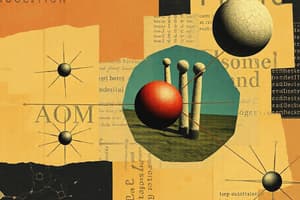Podcast
Questions and Answers
Which atomic model describes matter as being composed of indivisible particles?
Which atomic model describes matter as being composed of indivisible particles?
- Thomson
- Dalton
- Rutherford
- Democritus (correct)
What was a key feature of Dalton's atomic model?
What was a key feature of Dalton's atomic model?
- Solid sphere with no charge inside (correct)
- Negatively charged electrons in a positive sphere
- Electrons orbit the nucleus
- Electron clouds define regions of probability
Which atomic model was verified through the gold foil experiment?
Which atomic model was verified through the gold foil experiment?
- Schrodinger
- Rutherford (correct)
- Thomson
- Bohr
In which atomic model are electrons described as having wave properties?
In which atomic model are electrons described as having wave properties?
Which scientist is associated with the plum pudding model?
Which scientist is associated with the plum pudding model?
What concept does Bohr's atomic model emphasize?
What concept does Bohr's atomic model emphasize?
Which characteristic is common to all atomic models discussed?
Which characteristic is common to all atomic models discussed?
What is a significant feature of Rutherford's atomic model?
What is a significant feature of Rutherford's atomic model?
Flashcards are hidden until you start studying
Study Notes
Atomic Models Through History
- The atomic model has evolved over time, with scientists building upon each other's discoveries.
- Democritus proposed that matter is made up of indivisible particles, which he called atoms.
- John Dalton envisioned the atom as a solid sphere, similar to a billiard ball, with no internal structure.
- J.J. Thomson discovered the electron through the cathode ray experiment and proposed the "plum pudding" model. In this model, negatively charged electrons are embedded within a positively charged sphere.
- Ernest Rutherford conducted the gold foil experiment, leading to the discovery that atoms are mostly empty space with a dense, positively charged nucleus at the center. This model replaced the plum pudding model.
- Niels Bohr suggested that electrons orbit the nucleus in specific energy levels.
- Erwin Schrodinger further developed the atomic model by describing electrons as wave-like and existing in regions of probability known as "electron clouds". This model is referred to as the orbital cloud model.
Studying That Suits You
Use AI to generate personalized quizzes and flashcards to suit your learning preferences.




